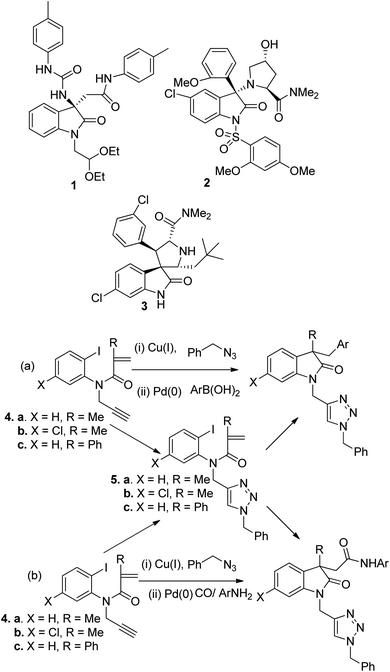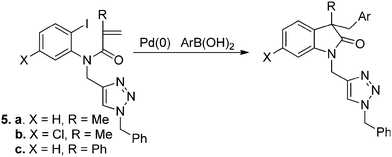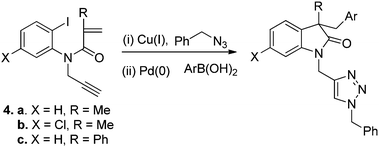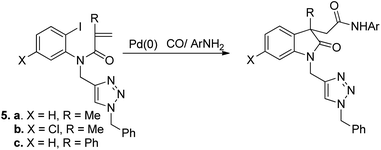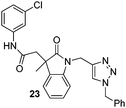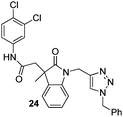Bimetallic (Cu/Pd) catalytic cascade reactions to 3,3-disubstituted oxindole analogues†
Gemma Packer,
Kurt Lepre,
Jayakanth Kankanala and
Visuvanathar Sridharan*
School of Chemistry, University of Leeds, Leeds, LS2 9JT, UK. E-mail: v.sridharan@leeds.ac.uk
First published on 5th December 2013
Abstract
Copper-catalysed click reaction followed by either a palladium-catalysed cyclisation-cross coupling or a palladium catalysed cyclisation–carbonylation/amination process to 3,3-disubstituted oxindole derivatives occurred in good yields.
The development of facile methods to heterocyclic scaffolds is critical to the drug-discovery process. Cascade or domino reactions have emerged as a powerful tool for synthetic chemists.1,2 These cascade processes generate a high level of molecular complexity in one efficient step, minimising solvent use, reagents, time and energy. Over the past decade we have developed powerful, widely applicable, highly regio-and stereo-selective palladium catalysed cyclisation-anion capture methodology to synthesise novel hetero and carbocycles.3–5 Recently others have also utilised the cascade reactions where carbopalladation is followed by coupling with an organoborane with considerable success.6–14 Our basic methodology would advance to a higher level of sophistication if the starter or “zipper” species could be extended to a bimetallic cascades or sequential one-pot processes. This is a novel area that will greatly expand the synthetic flexibility of the cascades whilst increasing the molecular diversity of the products. Therefore, we opted to explore a bimetallic (Cu/Pd) catalytic sequential one-pot click reaction followed by either palladium catalysed cyclisation-cross coupling (Scheme 1a) or carbonylation/amination (Scheme 1b) process to synthesise novel 3,3-disubstituted oxindole scaffolds (Scheme 1).
The important oxindole moiety is found in many natural products having several biological activities, as evidenced in the cyclic peptide Celogentin K15 and the spiro-oxindole alkaloids (−)-horsfiline16 and spirotryprostatin.17 Some important synthetic therapeutic agents also contain a 3,3-disubstituted oxindole core, as the potent gastrin/CCK-B receptor antagonist 1,18 the vasopressin/V1b receptor antagonist 2 (ref. 19) and a potent inhibitor of p53-MDM2 interaction 3.20
Initially we explored a sequential click-palladium cross coupling reactions. Thus 4a (1 mmol), benzylazide (1 mmol), sodium ascorbate (0.25 mmol) and CuSO4 (0.01 mmol) in tBuOH/H2O (4 mL, 1![[thin space (1/6-em)]](https://www.rsc.org/images/entities/char_2009.gif) :
:![[thin space (1/6-em)]](https://www.rsc.org/images/entities/char_2009.gif) 1) stirred at room temperature for 12 h afforded 5a in 88% yield. Next we carried out the palladium catalysed cyclisation cross coupling process using 5a (1 mmol), phenyl boronic acid (2 mmol), Pd(PPh3)4 (5 mol%) and Cs2CO3 (3 mmol) in dioxane/water (15
1) stirred at room temperature for 12 h afforded 5a in 88% yield. Next we carried out the palladium catalysed cyclisation cross coupling process using 5a (1 mmol), phenyl boronic acid (2 mmol), Pd(PPh3)4 (5 mol%) and Cs2CO3 (3 mmol) in dioxane/water (15![[thin space (1/6-em)]](https://www.rsc.org/images/entities/char_2009.gif) :
:![[thin space (1/6-em)]](https://www.rsc.org/images/entities/char_2009.gif) 1, 3 mL) stirred at 90 °C for 6 h gave 6 in 82% yield (Table 1, entry 1). Cyclisation cross coupling reactions utilizing 5 and variety of boronic acids are illustrated in Table 1. It appears for the reactions involving aryl boronic acids that they were not significantly affected by the electronic nature of the substituent present on the aryl ring or their position on the aryl ring. Overall, vinyl, aryl (electron donating and electron withdrawing) and heteroaryl boronic acids gave excellent yields of the palladium catalysed cascade products in the sequential process (Table 1).
1, 3 mL) stirred at 90 °C for 6 h gave 6 in 82% yield (Table 1, entry 1). Cyclisation cross coupling reactions utilizing 5 and variety of boronic acids are illustrated in Table 1. It appears for the reactions involving aryl boronic acids that they were not significantly affected by the electronic nature of the substituent present on the aryl ring or their position on the aryl ring. Overall, vinyl, aryl (electron donating and electron withdrawing) and heteroaryl boronic acids gave excellent yields of the palladium catalysed cascade products in the sequential process (Table 1).
Next we explored the one-pot sequential cascade reactions. After initial screening of solvents and copper salts we identified CuI as the catalyst and dioxane/water as the solvent of choice for the sequential one pot click palladium catalysed cyclisation-cross coupling reactions (Scheme 1a). Thus 4a (1 mmol), benzyl azide (1 mmol) and CuI (5 mol%) in dioxane/water (3 mL) and stirred for 12 h at 90 °C. Upon successful completion of the click reaction phenyl boronic acid (2 mmol), Pd(PPh3)4 (5 mol%) and Cs2CO3 (3 mmol) were added and the reaction stirred for a further 12 h at 90 °C afforded 6 in 62% yield. The successful one-pot reactions are shown in Table 2. Overall, aryl (electron donating and electron withdrawing) boronic acids gave excellent yields of the cascade products in the one-pot sequential process (Table 2).
Finally we further increase the molecular complexity of the oxindole scaffold via a sequential copper catalysed click reaction followed by a palladium catalysed carbonylation/amination processes (Scheme 1b).21 Thus 5a (1 mmol), Cs2CO3 (3 mmol), palladium acetate (10 mol%), tris 2-furyl phosphine (20 mol%) and 3-chloroaniline (1.5 mmol), under a carbon monoxide balloon in toluene at 100 °C for 12 h afforded 23 in moderate yield (Table 3, entry 1). Unfortunately the yield was not so high due to the problems in separation of the final product from the furyl phosphine oxide. HPLC was used to separate the final product. Modest yields (50–60%) were also obtained when using substrate 5b with either 3-chloroaniline or 3,4-dichloroaniline in the palladium catalysed carbonylation/amination cascade process (Table 3, entries 2 and 3).
Conclusions
In Summary, we have developed a sequential one-pot copper catalysed click reaction followed by either a palladium catalysed cyclisation-cross coupling reaction or a palladium catalysed cyclisation/carbonylation/amination cascades to 3,3-disubstituted N-alkylated oxindole derivatives in good yields.Acknowledgements
We thank Leeds University for support.Notes and references
- L. F. Tietze, Chem. Rev., 1996, 96, 115–136 CrossRef CAS PubMed.
- L. F. Tietze, G. Brasche, and K. Gericke, Domino Reactions in Organic Synthesis, Wiley-VCH Verlag GmbH & Co. KGaA, 2006 Search PubMed.
- R. Grigg and V. Sridharan, Pure Appl. Chem., 1998, 70, 1047–1057 CrossRef CAS.
- R. Grigg and V. Sridharan, J. Organomet. Chem., 1999, 576, 65–87 CrossRef CAS.
- R. Grigg, V. Sridharan and J. Zhang, Tetrahedron Lett., 1999, 40, 8277–8280 CrossRef CAS.
- K. Ishikura, N. Takahashi, K. Yamada and R. Yanda, Tetrahedron, 2006, 62, 11580–11591 CrossRef PubMed.
- B. Seashore-Ludlow and P. Somfai, Org. Lett., 2012, 14, 3858–3861 CrossRef CAS PubMed.
- R. Yanada, S. Obika, T. Inokuma, K. Yanada, M. Yamashita, S. Ohta and Y. Takemoto, J. Org. Chem., 2005, 70, 6972–6975 CrossRef CAS PubMed.
- C. H. Oh and Y. M. Lim, Tetrahedron Lett., 2003, 44, 267–270 CrossRef CAS.
- W. S. Cheung, R. J. Patch and M. R. Player, J. Org. Chem., 2005, 70, 3741–3744 CrossRef CAS PubMed.
- H. Yu, R. N. Richey, M. W. Carson and M. J. Coghlan, Org. Lett., 2006, 8, 1685–1688 CrossRef CAS PubMed.
- S. Couty, B. Liegault, C. Meyer and J. Cossy, Org. Lett., 2004, 6, 2511–2514 CrossRef CAS PubMed.
- M. Arthuis, R. Pontikis and J.-C. Florent, Tetrahedron Lett., 2007, 48, 6397–6400 CrossRef CAS PubMed.
- E. Marchal, J.-F. Cupif, P. Uriac and P. van de Weghe, Tetrahedron Lett., 2008, 49, 3713–3715 CrossRef CAS PubMed.
- H. Suzuki, H. Morita, M. Shiro and J. Kobayashi, Tetrahedron, 2004, 60, 2489–2495 CrossRef CAS PubMed.
- A. Jossang, P. Jossang, H. A. Hadi, T. Sevenet and B. Bodo, J. Org. Chem., 1991, 56, 6527–6530 CrossRef CAS.
- C. B. Cui, H. Kakeya, G. Okada, R. Onose, M. Ubukata, I. Takahashi, K. Isono and H. Osada, J. Antibiot., 1995, 48, 1382–1384 CrossRef CAS.
- M. Ochi, K. Kawasaki, H. Kataoka, Y. Uchio and H. Nishi, Biochem. Biophys. Res. Commun., 2001, 283, 1118–1123 CrossRef CAS PubMed.
- C. Serradeil-Le Gal, J. Wagnon, J. Simiand, G. Griebel, C. Lacour, G. Guillon, C. Barberis, G. Brossard, P. Soubrie, D. Nisato, M. Pascal, R. Pruss, B. Scatton, J. P. Maffrand and G. Le Fur, J. Pharmacol. Exp. Ther., 2002, 300, 1122–1130 CrossRef CAS.
- K. Ding, Y. Lu, Z. Nikolovska-Coleska, S. Qiu, Y. S. Ding, W. Gao, J. Stuckey, K. Krajewski, P. P. Roller, Y. Tomita, D. A. Parrish, J. R. Deschamps and S. M. Wang, J. Am. Chem. Soc., 2005, 127, 10130–10131 CrossRef CAS PubMed.
- X.-F. Wu, H. Neumann and M. Beller, Chem. Rev., 2013, 113, 1–35 CrossRef CAS PubMed.
Footnote |
| † Electronic supplementary information (ESI) available. See DOI: 10.1039/c3ra46906a |
| This journal is © The Royal Society of Chemistry 2014 |

